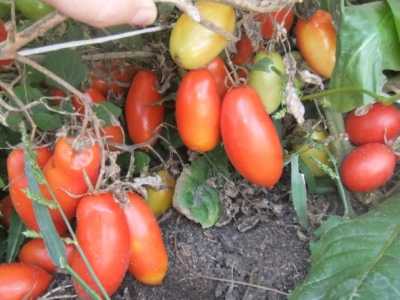
- Authors: Gavrish S.F., Kapustina R.N., Gladkov D.S., Sedin A.A., Nesterovich A.N., Volkov A.A., Semenova A.N., Artemyeva G.M., Filimonova Yu. A. (Scientific Research Institute of Vegetable Plant Breeding, LLC Gavrish Breeding Company)
- Year of approval: 2010
- Category: grade
- Growth type: determinant
- Appointment: universal
- Ripening period: mid-season
- Ripening time, days: 117-125
- Growing conditions: for open ground, for film greenhouses
- Transportability: good
- Marketable fruit yield,%: up to 98
The determinant Gazpacho variety is one of those that have the most pronounced taste. The universal tomato is used fresh, it is good in cooking, as well as in whole-fruit canning, for example, tomatoes in their own juice, not to mention the classic marinade. In addition to the above, Gazpacho is distinguished by good transportability, a high percentage of marketable fruit yield (about 98), as well as the ability to give a stable harvest not only in greenhouses, but also in the open field. This makes the variety very popular in the farming segment and in private plots.
Breeding history
Gazpacho was registered in the State Register of Breeding Achievements in 2010. The originators of the variety are breeders S. F. Gavrish, R. N. Kapustina, D. S. Gladkov, A. A. Sedin, A. N. Nesterovich, A. A. Volkov, A. N. Semenova, G. M. Artemyeva, Yu. F. Filimonova, representatives of the Scientific Research Institute of Vegetable Breeding LLC, as well as the Gavrish Breeding Company LLC.
Description of the variety
A semi-spreading, undersized bush about 40 cm high has medium branching and foliage. The stems are covered with medium-sized dark green foliage. The yellow flowers are collected in simple inflorescences, the fruits are attached to the articulated peduncle. The tomato grows until the apical brush is formed, after which the growth stops, which eliminates the need to pinch the growth point.
The main qualities of the fruit
The shape of the fruit is cylindrical, slightly ribbed. Some see it as similar to peppers, others compare it to barrels. Unripe tomatoes are colored milky green, changing the color to bright red during the period of technical and physiological ripeness.
Taste characteristics
The dense pulp is covered with a dense skin, which ensures keeping quality up to one and a half months, the possibility of transportation over long distances. The fruits have a pronounced tomato flavor with a unique balance of sugar content (2.2–2.6 g) and acid, and contain from 3.4 to 5.4% of dry matter. The variety has an interesting feature: tomatoes taken from bushes grown in the open field are much tastier than greenhouse ones.
Ripening and fruiting
Gazpacho belongs to the mid-ripening category of tomatoes, its approximate ripening period is 117-125 days, the fruits ripen together and almost simultaneously. Harvesting begins at the end of June in greenhouses, and outdoors at the end of July - mid-August, this period is the peak of fruiting.
Yield
The variety belongs to fruitful, therefore it is willingly used by farmers - 4.7 kg of fruits are harvested from one square meter, 194-321 centners per hectare.
The timing of planting seedlings and planting in the ground
Sowing for seedlings occurs in late March - early April, adult seedlings are transplanted into greenhouses in early, mid-May at the age of 40 days, in open ground a little later - depending on the climatic conditions of the region.

Growing tomato seedlings is an extremely important process, because it largely depends on whether the gardener will be able to harvest at all. All aspects must be taken into account, from seedbed preparation to planting in the ground.
Landing scheme
For optimal plant development, a root planting scheme of 40x60 cm is used, there should not be more than three tomatoes per meter.

Growing and care
Seedlings of Gazpacho are ready for planting in a permanent place after 40-45 days in film and polycarbonate greenhouses, in open ground a couple of weeks later. For cultivation, choose a well-lit area, fertile aerated soil with a neutral pH level. The last three conditions are optional, since fertility can be increased by the introduction of nutrients, acidity can be leveled with bone, dolomite flour, and lime fluff. River sand or cereal husks will help to make the heavy, dense soil loose. Rice and buckwheat husks, in addition, enrich the soil with useful minerals, vitamins, biohumus, as it actively attracts earthworms.
The soil is prepared 1-2 weeks before transplanting. Organic matter (humus, compost, bird droppings), mineral complex fertilizers, wood ash are introduced. After planting, the soil in the holes is compacted and spilled with warm water. Further care consists in regular watering, weeding, loosening, hilling, removing excess foliage. In addition, it is necessary to carry out preventive treatments and feeding with nitrogen, potassium-phosphorus preparations, as well as infusion of nettle, mullein. When grown, the bush is formed into one stem.




A plant needs different micronutrients at each stage of growth. All fertilizers can be divided into two groups: mineral and organic. Folk remedies are often used: iodine, yeast, bird droppings, eggshells.
It is important to observe the rate and period of feeding. This also applies to folk remedies and organic fertilizers.
Disease and pest resistance
Despite the fact that the variety is resistant to verticillium and fusarium, it is tolerant to fungal diseases, and also defenseless against pests:
aphids, nematodes;
bear, slugs;
Colorado potato beetle, spider mite.
The listed problems oblige the gardener to take preventive measures in the form of the use of insecticides and fungicides. Unfortunately, slugs do not react to toxic substances, so the most effective method of dealing with them is manual. Treatments are recommended to be carried out two to four times per season.


Resistant to adverse weather conditions
Plants cope well with temperature extremes.
Growing regions
Gazpacho is adapted for cultivation in the southern regions: Kuban, North Caucasian region and Stavropol region. These districts allow cultivation of the variety not only in greenhouses, but also in the open field.

























































































